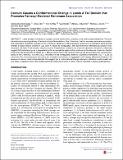Calcium Causes a Conformational Change in Lamin A Tail Domain that Promotes Farnesyl-Mediated Membrane Association
Author(s)
Kalinowski, Agnieszka; Qin, Zhao; Coffey, Kelli; Kodali, Ravi; Buehler, Markus J.; Dahl, Kris Noel; Losche, Mathias; ... Show more Show less
DownloadBuehler_Calcium causes.pdf (1.293Mb)
PUBLISHER_POLICY
Publisher Policy
Article is made available in accordance with the publisher's policy and may be subject to US copyright law. Please refer to the publisher's site for terms of use.
Terms of use
Metadata
Show full item recordAbstract
Lamin proteins contribute to nuclear structure and function, primarily at the inner nuclear membrane. The posttranslational processing pathway of lamin A includes farnesylation of the C-terminus, likely to increase membrane association, and subsequent proteolytic cleavage of the C-terminus. Hutchinson Gilford progeria syndrome is a premature aging disorder wherein a mutant version of lamin A, Δ50 lamin A, retains its farnesylation. We report here that membrane association of farnesylated Δ50 lamin A tail domains requires calcium. Experimental evidence and molecular dynamics simulations collectively suggest that the farnesyl group is sequestered within a hydrophobic region in the tail domain in the absence of calcium. Calcium binds to the tail domain with an affinity K[subscript D] ≈ 250 μM where it alters the structure of the Ig-fold and increases the solvent accessibility of the C-terminus. In 2 mM CaCl[subscript 2], the affinity of the farnesylated protein to a synthetic membrane is K[subscript D] ≈ 2 μM, as measured with surface plasmon resonance, but showed a combination of aggregation and binding. Membrane binding in the absence of calcium could not be detected. We suggest that a conformational change induced in Δ50 lamin A with divalent cations plays a regulatory role in the posttranslational processing of lamin A, which may be important in disease pathogenesis.
Date issued
2013-05Department
Massachusetts Institute of Technology. Department of Civil and Environmental Engineering; Massachusetts Institute of Technology. School of EngineeringJournal
Biophysical Journal
Publisher
Elsevier
Citation
Kalinowski, Agnieszka, Zhao Qin, Kelli Coffey, Ravi Kodali, Markus J. Buehler, Mathias Losche, and Kris Noel Dahl. “Calcium Causes a Conformational Change in Lamin A Tail Domain That Promotes Farnesyl-Mediated Membrane Association.” Biophysical Journal 104, no. 10 (May 2013): 2246–2253. © 2013 Biophysical Society
Version: Final published version
ISSN
00063495
1542-0086